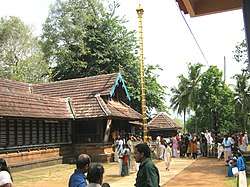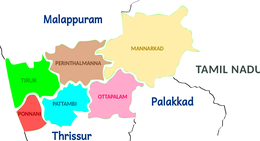Kingdom of Valluvanad
Valluvanad refers to a region in present-day central Kerala and was, at various periods, an independent kingdom (officially the Kingdom of Vellattiri[1]), a district within the kingdom of the Chera Perumals of Mahodayapuram,[2][3] and a taluk of the Malabar district within the Madras presidency. It was a subdistrict in the South Malabar region.
Kingdom of Vellattiri Valluvanad | |
|---|---|
| 10th century AD–18th century AD | |
 Thirumandhamkunnu Temple | |
| Capital | Angadipuram, Malappuram district, Kerala |
| Common languages | Malayalam. |
| Religion | Hindu |
| Government | Monarchy |
| Valluvanattu Raja | |
| History | |
• Established | 10th century AD |
• Disestablished | 18th century AD |
The earlier Valluvanad had parts of Tirur and Ponnani Taluks within it. Valluvanad Taluk (Under British Rule) has been described as the historical region between the knolls of Pandalur Hills and the seashore of Ponnani.[4] The country covered the Bharathapuzha river basin in the south to the Pandalur Hills in the north. On the west, it was bounded by the Arabian Sea at the port Ponnani and on the east by Attappadi Hills. Presently, Valluvanad loosely refers to a region bound by the current Perinthalmanna Taluk (Malappuram District) Mannarkkad Taluk, Pattambi Taluk and Ottappalam Taluk (Palakkad District)
Chieftains and members of the "Vallabha" family appear in inscriptions as early as 10th century AD. The Vellattiri Raja initially exercised suzerain rights over a large portion of central Kerala. The raja even held the presidency of the Mamankam, an ancient festival held once in twelve years at Tirunavaya (which was later usurped by king of Calicut). Their territorial control gradually eroded with the rise in stature of the kings of Calicut (the zamorins).
When the Mysore Sultans invaded Kerala in late 18th century, the raja found asylum in Travancore. Tipu Sultan ceded Malabar to the English Company in 1792. The Company took over the management of the country in May 1793.[5]

Variations of the name
- Valluvanad - Valluvanadu - Valluvanatu - Valluvanat - Walluvanad - Walluvanatu[5]
- Swaroopam (Svarupam) - Arangottu[5] (Aarangottu)
- Vellattiri - Vellatiri - Velatra - Velnatera (title of the ruler)[5] - Valluvakkonathiri
Official names
- Official name of the kingdom - the Kingdom of Vellattiri (source: Logan (No. XIII))
- Official title of the Raja - Vallabha Raja (in the treaty with English) (source: Logan (No. XIII))
Hereditary title
- Rajasekhara (or Rayaran/Irayira Chekaran or Irayiravar[3])
- Rajasekhara and his son Vellan Kumaran (inscription)
- Irayaran Chattan, the utaiyavar of Valluvanatu, in Jewish Copper Plates (1000 AD)
Headquarters
The headquarters of Valluvanad was the present day town of Angadipuram, which is now famous for its Thirumandhamkunnu Temple. The guardian deity of the Valluvanad royal family was Thirumandhamkunnu Bhagavati at Thirumandhamkunnu Temple (Ayyar, 93).
The Brahmins of Sukapuram were supporters of Valluvanad.[6]
History
Nadu in the Chera Kingdom
The earliest epigraphic record mentioning Valluvanad is from inscriptions at Tiruvotriyur (late 10th century CE) describing the life of Vellan Kumaran, son of the Valluvanad Chieftain Rajasekhara. Vellan Kumaran is described as a commander in the Chola army in the famous battle of Takkolam (948-49 CE) and considered a close confidante of Chola prince Rajaditya. Rayiran Chathan, the chieftain (the udayavar) of Valluvanad, is mentioned as a witness in the Jewish copper plates of Cochin (c. 1000 CE) issued by the Chera king of Kodungallur. Valluvanad rulers also find mention in the Parthivapuram Sasanam and Viraraghava Pattayam (13th century CE). Valluvanad, or the land of the Valluva (Vallabha) people, was one of the nadus (the main divisional administrative unit) within the kingdom of the Chera Perumals of Mahodayapuram (until CE 1124).[2][3] The chieftain of Valluvanad, the nadu-udayavar, claimed authority through kinship and descent.[3] The Hundred, the military organisation of the chiefdom, was the "aru-nurruvar" (the Six Hundred).[3] The Vellattiri chieftain (the udayavar) initially exercised suzerain rights over a large portion of central Kerala.[3]
- Irayira Chekaran of Valluvanad was involved in a temple resolution to take over the village of Taviranur and bring it under the village of Sukapuram (inscription).[3][7]
- Irayiravar, the Valluvanad chief, is seen in three temple transaction-related inscriptions from Avattiputhur/Avittathur (near Kodungallur) - an example of the chief performing regulatory functions outside his chiefdom.[3]
- When a market centre was established at Irinjalakkuda (namely "Bhaskarapuram"), the protection of the area was given to the "aru-nurruvar" of Valluvanad (inscription dated to the close of the 10th century).[6][3][8] - an example of the Hundred Organisation performing regulatory functions outside the chiefdom.[3]
Zamorin's encroachments
After the fall of Chera Kingdom in the 12th century, the right to preside over the Tirunavaya Mamankam festival (the Rakshapurusha) passed to the Vellattiri. When the zamorin (the samoothiri) of Calicut became a major force in Kerala, they made inroads into the Vellattiri kingdom and even usurped the right to preside over the Mamankam (Ayyar, 91). The zamorin eventually extended his kingdom as east as Nilambur and as deep as Venkattakota (Ayyar, 121).
Ever since, the Vellattiri used to send groups of suicide warriors (known as the Chavers) to kill the king of Calicut during the Mamankam and the Taippuyam festivals and recover the long-lost right.[9]
According to historians, "...the caver of Valluvanatu died fighting to avenge the death or defeat of their master and died fighting regularly at Tirunavaya for a long period. It means that the caver died fighting at Tirunavaya even after many generations. Thus it takes the form of blood feud..."[9]
Notes from K. V. Krishna Ayyar (1938)
- Brahmin Raja of Tirumanasseri ceded Ponnani to the zamorin as the price for his protection from Valluvanatu and Perumpatappu (Cochin) (Ayyar, 101-102)
- Tradition says that the zamorin, despair for success at Tirunavaya, sought divine help by propitiating the Tirumandhamkunnu Bhagavati (Ayyar, 101-102).
- Malappuram, on the road between Calicut and Vellattiri's headquarters, was entrusted by the zamorin a member of Varakkal Paranampi's family (Malappuram Paranampi) (Ayyar, 121-22). Nilambur was placed under Taccharakkavu Eralan, and Vallappanattukara under Tarakkal Eroma Menon (the commander of Chunganad) and Manjeri under the Karanappad (Ayyar, 121-22).
- Kariyur Mussad (the Brahmin minister and general of Vellattiri) was captured and put to death at Pataparamba and his lands (the Tens Kalams and Pantalur) were occupied (Ayyar, 121-22)
Mysore's invasion
The country marked as "Valluvanad Proper" in the Company records was sole the remaining territory under the control of the Valluvanad Raja at the time of the Mysorean invasion of Malabar .The Raja and his family fled to Travancore. (source: Logan (No. XIII))
- According to the ancient laws of Kerala, many Nair chiefs and Nairs were liable to follow the Valluvanad Raja in battles. These chiefs were allowed hold their land without paying revenue or tribute to the Raja. Mysore rulers destroyed this custom (source: Logan (No. XIII))
- Grants were made of the lands to the temples, and to the Brahmins, all which lands were by the sultans brought to account in the revenue (the lands were taken from the Brahmins) (source: Logan (No. XIII))
At the time of the Mysore conquest the following amsams (of the 1887 Valluvanad and Ernad taluks, the Valluvanad Proper) remained to Vellattiri (reference: William Logan (1887))
- Angadipuram
- Perinthalmanna
- Melattur
- Keezhattur
- Pallippuram
- Mankada
- Arakkuparamba
- Chettanallur
- Puzhakkattiri
- Valambur
- Karyavattam
- Nenmini
- Kodur
- Pang
- Kolathur
- Kuruvambalam
- Pulamanthole
- Elamkulam
- Vettattur
- Kottopadam
- Arakurissi
- Tachampara
- Anamangad
- Paral
- Chembrasseri
- Pandikkad
The following regions (known as Valluvanad-zamorin) were controlled the zamorin of Calicut ("latest acquisition" by zamorin from Vellattiri) (reference: William Logan (1887))
- Tuvvur
- Thiruvizhamkunnu
- Thenkara
- Kumaramputhur
- Karimpuzha
- Thachanattukara
- Aliparamba
English takeover of Kerala
Reference: William Logan (1887)
- Valluvanad Proper (Vellattiri/Valluva Konatiri or Valluvakon Raja)
Valluvanad Proper was the remaining territory under the control of the Valluvanad Raja at the time of the Mysore conquest (the Raja and his family fled to Travancore during the Mysore conquest). Tipu Sultan ceded Malabar to the English Company in 1792.
The Company reinstated the Vellatiri Raja's country to the Raja on 30 July, 1792 (the Raja met with William G. Farmer Esq. and Major Alexander Dow at Calicut and "hoped to hold his former countries as manager of the Company, paying to them the revenues collected from the said countries". The Raja undertook to pay a sum of Rs. 38,410.20 as the lease amount). The Raja was obliged to collect the sum within one year. (source: Logan (No. XIII)). In May 1793 the Joint Commissioners dismissed the Raja, fixed his pension and started managing the country directly (pages 479-80).
Divisions of the country as stated by the Raja (July 1792) (source: Logan (No. XIII)).
- Melattur
- Angadipuram
- Mannarkkad
- Kappu
State
Branches (tavalis)
- Eldest male member (in the female line) - Valluvakkonatiri (Valluvakkonathiri)
- Tavalis in the senior lineage of Valluvanad - the House of Arangottu
- Aripra tavali
- Mankata tavali
- Katannamanna tavali
- Ayiranali tavali
- Junior lineage of Valluvanad - the Vallotis (Vellodis)
Reference: V. V. Haridas (2003)
Royal titles
Royal titles according to seniority were –
- Valluvakkonathiri – eldest male member (in the female line)
- Vellalpad
- Thacharalpad
- Edathralpad
- Kolathur
- Padinjarekkara
Sthanis
The eldest five male sthanis (the designates) were titled as (all five were eligible for malikhana)
- Valluvakkonathiri – eldest sthani
- Vellalpad
- Thacharalpad
- Edathralpad
- Kolathur Thampuran
- Padinjarekkara Thampuran – nominated by Vellattiri (the thampuram had rights over some landed property and privileges).
Thampurattis
The eldest two female members were titled as (all two were eligible for malikhana)
- Kulathur Thampuratti – the eldest thampuratti of the family
- Kadanna Mootha Thampuratti – the next eldest thampuratti
Apart from this, the eldest female members of each kovilakam have their own rights and privileges.
Government
- Karuvayoor Moosad – the Brahmin chief minister of Vellattiri.
- Kunnathattil Madambil Nair (Mannarghat Nair) – the chieftain (desavazhi) who looked after the affairs of the eastern boundary and hilly areas of Vellattiri.
- Chondathil Mannadiar (Puthumana Panicker)
- Nair of Kavada
- Other dignitaries consisted of 14 swaroopis, which included
- Two Nairs from central regions
- Two Namboothiris
- Two persons of the royal house
- Four Panickers
- Elampulakkad Achan
- Kulathur Warrier
- Uppamkalathil Pisharody
- Pathiramanna Vellodi
- Parakkatt Nair
- Kakkoott Nair
- Mannarmala Nair
- Cherukara Pisharody
External links
Sources
- Source: Logan (No. XIII).
- Narayanan, M.G.S. (2013). Perumāḷs of Kerala : Brahmin oligarchy and ritual monarchy : political and social conditions of Kerala under the Cēra Perumāḷs of Makōtai (c. AD 800-AD 1124). Thrissur: CosmoBooks. ISBN 9788188765072.CS1 maint: ref=harv (link)
- Ganesh, K. N. (2009). Historical Geography of Natu in South India with Special Reference to Kerala. Indian Historical Review, 36(1), 3–21.
- S. Rajendu - History of Valluvanad - from pre-historic times to A.D. 1792, Malayalam, Perintalmanna, 2012
- "princelystatesofindia.com". Archived from the original on 16 March 2012. Retrieved 20 July 2011.
- Gurukkal, Rajan. “A NEW EPIGRAPH REFERRING TO ERNADU.” Proceedings of the Indian History Congress, vol. 37, 1976, pp. 526–531.
- SII, Vol. V, No. 775.
- Ramavarma Research Institute Bulletin, Vol. Ix, No. 1, p. 44.
- Haridas V.V. “DYING FOR A CAUSE: ‘CAVER’ OF MEDIEVAL KERALA.” Proceedings of the Indian History Congress, vol. 61, 2000, pp. 492–500.
Valluvanad Granthavari, from pre-historic times to A.D.1792, S. Rajendu, Perintalmanna, 2015